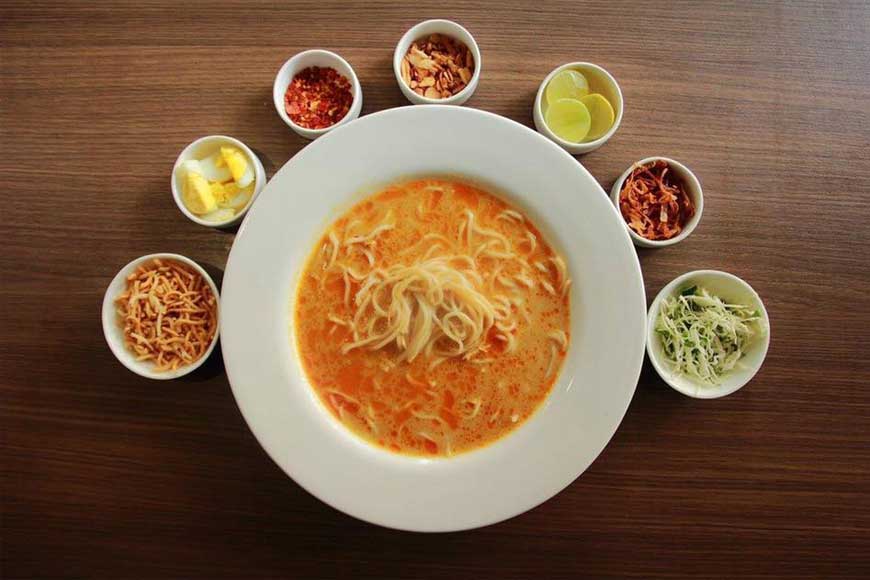Burmas delicious connect with Kolkata

Burma, Myanmar, has always had a special place in every Bengali's heart, thanks to the connections with Netaji Subhash Chandra Bose. Over the past few years, it has taken up a special place on our plates too. At least a dozen restaurants in the city, both chains and standalone establishments, have introduced Khao Shuay or Khaukswey, the most famous Burmese export, after its teak and a classic Hindi film song with the two words: “Rangoon” and “Telefoon”.

The popularity of this dish which has been on the ascent, may have something to do with the fact that it packs in all the hearty elements that a Bengali palate desires – protein in the form of meat or sea food and eggs, carbs in the form of the silken noodles (sometimes rice), a dash of lime, a pinch of green chillies, a velveteen coconut milk gravy, the crunch of 'cheene badam' and a topping of fried onion and chopped coriander and roasted garlic. It has the 'jhol' (the broth) and the 'jhal' (it can be super spicy) and is substantial enough to be a one-pot dish that can be customised according to your taste. What more can a foodie ask for?

Anyone who has been to Chanda Dutta's deliriously famous eponymous restaurant in Golpark, will tell you that Burmese cuisine is more than the noodle and meat-in-coconut milk-broth dish. Over the years she has taken great pains to introduce gourmands to the variety and richness of the cuisine with her elaborate pop ups and regular menu that feature other than the Ong No Khaukswey, the Boo Thi Gyaw (fritters made with gourd), the Hto Boo Thoke, (a salad made with Burmese tofu), the La Phet Thoke (pickled tea leaves salad) besides the potent Balachaung (a shrimp condiment) and Mohinga (noodle and fish soup).

Dutt, who was born and raised in Taunggyi, in Shan State, ate this flavourful and diverse food at home. Like a host of Bengali families that left Burma during the 60's unrest, Dutt came to Kolkata with a lifetime of memories and a bagful of recipes, courtesy the Barua chefs and ayahs at home. She began to introduce the dishes at her pop ups, testing the waters so to speak, till her restaurant threw open its doors to a city that was ready for the culinary ride.
It is different with Bibi Sarkar, fondly remembered for the head and heart behind Taaja’s, the restaurant that first introduced Burmese cuisine to Kolkata sometime in the 80s. Until then, points out heritage cuisine expert Pritha Sen, Burmese cuisine was confined to the home kitchens of the immigrants -both Bengali and others. The rudimentary momo joints started by some of them were less adventurous, as they preferred to stick to food that was easy on the pockets and required very little inventory. Some of the clubs however, thanks to the chefs, who had been trained or worked in Burma, had something that was like the Khaokswey. But it was Bibi who put the dish on the city's culinary map. And Kolkata was hooked forever.
Sarkar, who introduced several cuisines at Taaja's, admits, Burmese cuisine happened to her by accident. “I have never been there, no one from my family ever has,” she says. “I just found the recipe at home one day and decided to try it out.” The recipe, belonged to her mother-in-law, who was a fabulous cook and held on to her recipes for dear life. It was after she passed away that Sarkar chanced upon the recipes and introduced her family and later her customers to food from all over the world. It was during her research on Burmese cuisine, that Sarkarstumbled upon other dishes that were potential crowd pleasers – pork cooked with pumpkin, the Balachaung and the La Phet Thoke, all of which she perfected and has recreated at some of her pop ups.
No two Khao Shay served at restaurants across the city, are alike. Some serve it in a watery consistency. Others prefer a creamier gravy. But what is common to all of them is that, There is always that one group that will order it. Because it is a great dish to be shared. From Mamagoto to Kung Pao, from Tutu's Hut to 6, Ballygunj Place, the inclusion of the many avatars of the Khaokswey is yet another example of the city's ability to embrace a culture through its cuisine.









